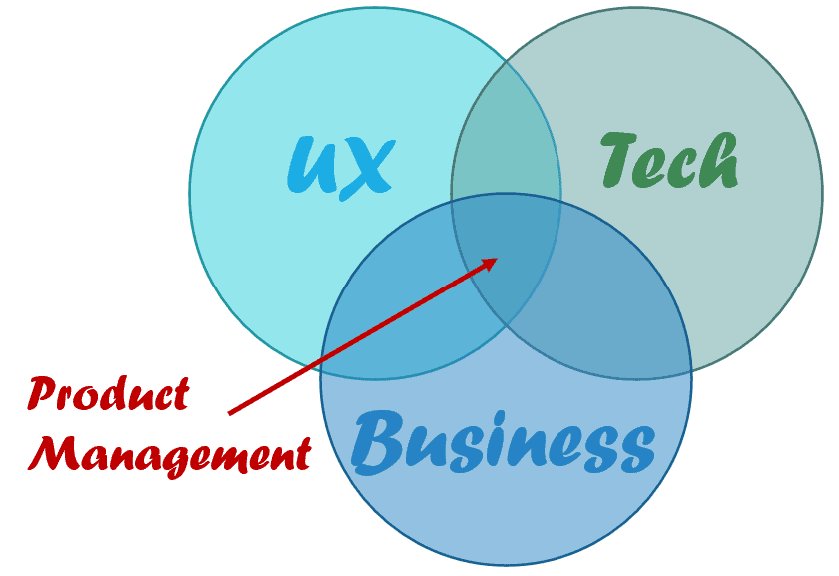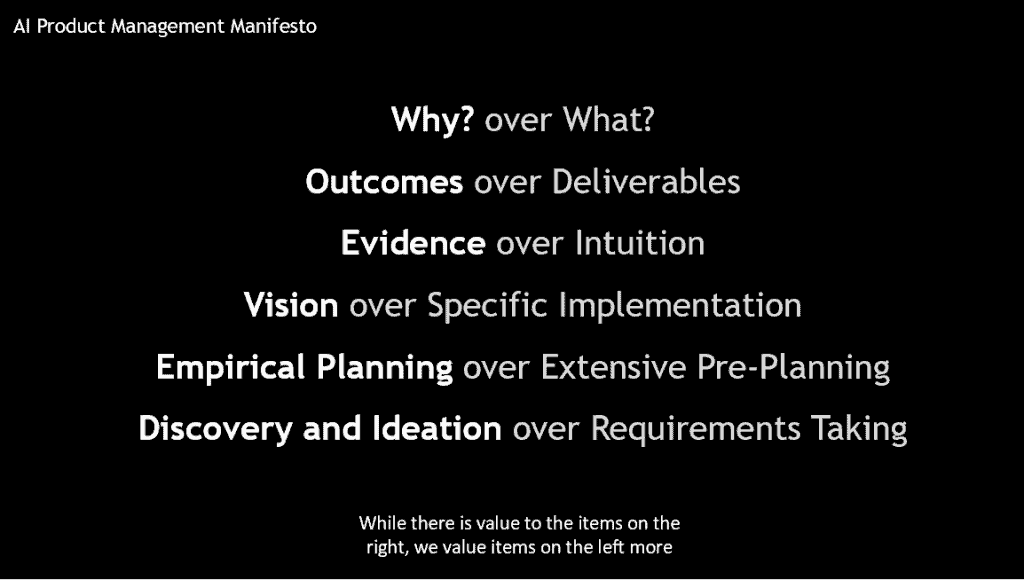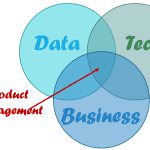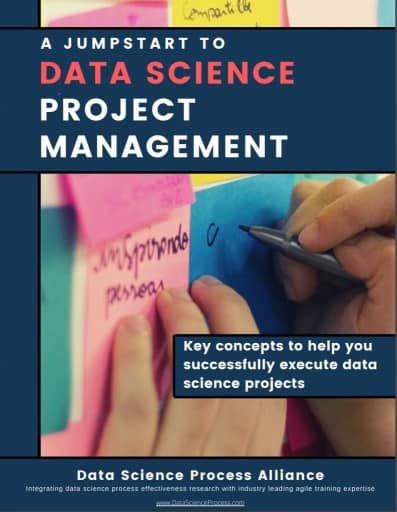As artificial Intelligence transitions from merely research endeavors into practical use cases for mainstream organizations, it isn’t just big tech that needs professionals with specialized AI talent. Rather, organizations of all sizes and across all industries are leaning on AI Product Managers to ideate, develop, and monetize AI products.
To better understand this exciting role, let’s first explore the field of AI Product Management. Then, we’ll understand the AI Product Manager role. And to understand how to better manage AI products, we’ll end by grasping the six principles as described in the AI Product Management Manifesto.
What is AI Product Management?
The Product Management Venn Diagram
Product Management is the practice of developing, launching, and supporting products. It is often represented at the intersection of three domains:
- Business – Products focus on maximizing value for key stakeholders. This involves coordination and leadership across multiple business domains such as marketing, finance, and often operations.
- Technology – Products need to be built. While Product Managers don’t necessarily need to code, they do need to understand the basic technical options, constraints, and processes to best guide the development of the product.
- User Experience (UX) – Products that don’t provide a good user experience generally don’t get used (unless you’re Ticketmaster).

The AI Product Management Venn Diagram
Some AI products have a user-facing component such as Netflix’s recommendation system. However, many AI products do not have a significant (or any) user-facing component. Indeed, many AI products generate output into internal files that are then shared with other systems.
While AI products may not always have a user-facing component, data is universally critical across all AI products.
Indeed, the collection, storage, transformation, analysis, and maintenance of data are all core aspects of any AI Product. Thus, I’ll define an AI Product Venn Diagram by replacing UX with Data. Keep in mind that UX is still important for some AI products depending on the use case.

Definition of AI Product Management
Bringing this all together, I define AI Product Management as:
“The practice of managing business, technology, and data to develop, launch, and operate AI Products”
Who is the AI Product Manager?
A Brief History of the AI Product Manager Role
The product manager role was born out of the need for larger companies to drive value out of consumer packaged goods like dish soap or toothbrushes.
Software companies adapted this role to build, improve, and monetize digital products. Just consider the app that you’re using on your desktop, phone, or tablet you’re using to read this post. There’s probably one or several product managers who decided how to develop this product, the functionality that it has, and how to get it into your hands.
Throughout the 2010s, big tech firms further branched out the product manager to oversee machine learning products. Consider that you found this blog post from a search engine or as recommended content from a social media platform. Again, there are probably several product managers who helped develop these.
Now organizations across every industry and size are embedding AI into their systems. To manage the development, launch, and operations of these intelligent systems, organizations are increasingly carving out roles for AI Product Managers.
AI Product Manager Role and Responsibilities
The AI Product Manager’s specific responsibilities vary widely based on the use case, organization, and industry. However, universally, they are responsible for the success of the product(s) they oversee in alignment with the broader stakeholder needs. Typical roles and responsibilities for AI Product Managers include:
Defining the bigger picture:
- Conduct research on AI and industry-specific trends
- Identify opportunities where advanced analytics, artificial intelligence, and machine learning can solve specific needs
- Develop a compelling product vision and communicate that vision
- Manage a product roadmap that clearly maps future releases to long-term product strategy
- Deliver product increments using Agile best practices for data science
- Define the Minimal Viable Product (MVP) and build effective feedback loops
Managing the product backlog:
- Manage a list of product ideas
- Break down the backlog into bite-sized pieces of value
- Ensure the backlog is transparent and understood
- Prioritize backlog items
Steering product development:
- Identify the appropriate model and business outcome metrics to measure the product success; monitor and track model and product performance against these metrics
- Work with data scientists, ML engineers, analysts, and software developers to guide the development of the product
Driving market success:
- Work with marketing teams to launch the product
- Own the product throughout the entire data science product life cycle. This extends beyond the project to make the product and includes ML Ops
- Drive value from the product by evangelizing usage and (if needed) monetizing the product
- Ensure the product and data usage complies with responsible AI best practices
Alternative or Similar Job Titles
It’s OK to get confused about which title means what. Indeed, there are many titles that overlap with AI Product Management. And sometimes different organizations use different titles to designate the same role. Other titles you might find used include:
- Product Manager – As AI is blended into everyday products, the “AI” specific descriptor might be dropped.
- Machine Learning (ML) Product Manager – This title tends to be used interchangeably with “AI Product Manager”.
- Data Science Product Manager – This title also tends to be used interchangeably with “AI Product Manager”.
- Product Owner or AI Product Owner – Some organizations use “Product Owner” interchangeably with “Product Manager”. Or this title could designate that the team uses Scrum or Data Driven Scrum. Or to add to the confusion, organizations might have both “Product Owners” (who are more tactically focused on current and upcoming development) and “Managers” (who drive the broader product strategy and manage external factors).
- Analytics Product Manager – This related role delivers business intelligence products.
- Data Product Manager – This related role delivers data sets that are internally re-used and often licensed to other organizations.
- Data Science Project Manager – This related tactical role focuses less on the what and the why and more in how to coordinate across team members and teams to data science projects.
Don’t Miss Out on the Latest
Sign up for the Data Science Project Manager’s Tips to learn 4 differentiating factors to better manage data science projects. Plus, you’ll get monthly updates on the latest articles, research, and offers.
The AI Product Management Manifesto
An AI Product Manager needs to be able to manage multiple – and often competing – demands. Common tradeoffs they have to resolve include:
- Do you launch now to get a first-mover advantage? Or wait until the model is more accurate?
- How much planning should the team do before we start?
- We could deliver on that stakeholder’s specific request to keep them happy. But is that what they really need?
- Using Customer Data Set Y is legal. But would this violate your customers’ trust?
Managing these tradeoffs is perhaps the most challenging aspect of the role.
To help AI Product Managers better determine the best course of action, they should define a set of guiding principles in advance so that they understand what they driving toward. The specific principles will vary based on the individual, team, and organizational goals. However, below is a good set of principles you could consider adopting.
Using the Agile Manifesto format, the AI Product Management Manifesto lists out several items. All of these are important – don’t ignore any of them. However, when faced with a tradeoff decision, weigh your decision more toward the items on the left because these are more important.

Why? over What?
What you deliver is important. However, accomplishing the why behind your objective is more important.
Outcomes over Deliverables
Don’t ignore the Deliverables you’re trying to ship. But measure these based on outcomes that these deliverables create when they are combined.
Evidence over Intuition
Intuition helps you make decisions – don’t ignore it. However, whenever possible, make decisions based on Evidence.
Vision over Specific Implementation
Drive toward the Vision. Everything implemented should build toward that vision. Don’t lose focus with items that don’t support that vision.
Empirical Planning over Extensive Pre-Planning
Your initial assumptions are wrong. So don’t drive toward a rigid plan based on those wrong assumptions. Rather, start with sufficient planning, deliver something, learn from it, take what you’ve learned, and revise your plan accordingly.
Discovery and Ideation over Requirements Taking
The requirements you gather are also wrong – at least in part. To understand the best solution, discover the true opportunity/problem and ideate solutions that fulfill that opportunity.
Finals Thoughts
The AI Product Manager branches off from more generalized Product Manager roles. With the rapid adoption of AI across multiple organizations, the role is becoming more crucial. Through this post, I hope you’ve gained a greater appreciation for this specialized role and learned some concepts that you can apply to your job and organization. Even better, hopefully, you use this to build a recommendation engine that helps users find great content – and drives more traffic to this post 🙂
Learn More:
- O’Reilly has a few posts and a report covering AI Product Management.
- Bhatti offers similar insights in his Essential Guide to AI Product Management post shares but has a different take on certain aspects including yet another venn diagram.
- Martin Fowler’s Products over Projects post inspired much of the AI Product Management Manifesto.
- There’s a good 90-minute talk from a Google Product Manager on How to be a good machine learning product manager
- Enroll in the Data Science Team Lead Plus course which prepares professionals for the AI Product Manager role.
Get Training from the Organization that Defined Data Driven Scrum






